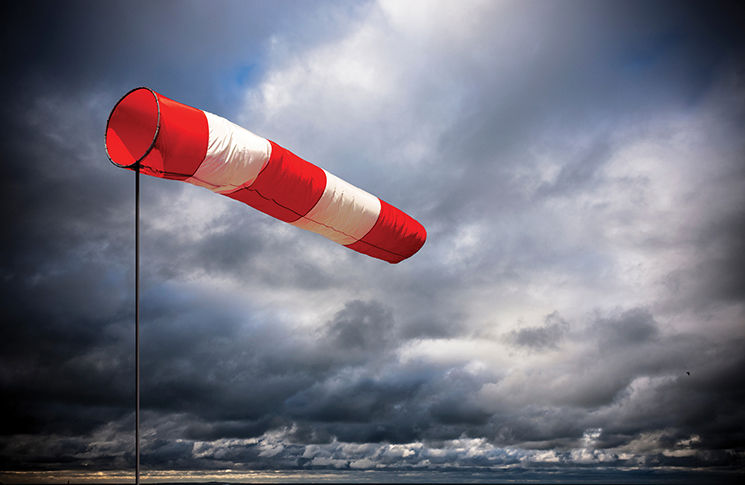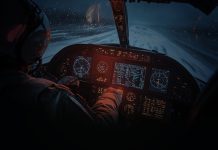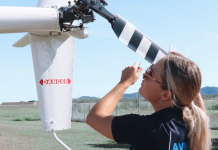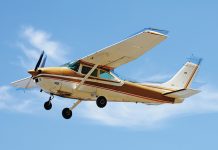‘Hic sunt dracones’ – here be dragons – was a term used on the edges of medieval maps to indicate unexplored and dangerous territories. Beyond the explored parts, people did not know what lurked nor what potential dangers existed. Could there even be dragons? No one knew.
In the limits section of some helicopter flight manuals, quaint phrases such as ‘has been demonstrated in sideways and rearwards flight up to 17 knots’ can be found. Can I exceed 17 knots? Is 17 knots a real limit? What lives past 17 knots?
Should the term ‘beware of dragons’ be resurrected and applied to helicopter flight manuals? It would obviously gain people’s attention and make pilots think about what they were about to do.
Unfortunately, 2 helicopter pilots found the dragons that lie beyond the flight manual’s maximum demonstrated crosswind.
An English field
In England in 2007, a low-time helicopter pilot planned to fly a Bell 206 Jet Ranger helicopter which was parked in the middle of an open field1. At a nearby airfield, the wind was reported as 075 degrees at 16 knots, gusting to 27. The Jet Ranger flight manual contained advice that the helicopter had been ‘demonstrated in sideways and rearwards flight up to 17 knots’.
The pilot started the helicopter and, to give themselves more room to take off, decided to taxi downwind along the length of the field to the far end. This gave them the full length in which to take off. This decision on its own without other considerations seems like a good idea.
A pedal turn was conducted and the helicopter hover taxied downwind to the end of the field. Here a spot turn was required to face into the wind for take-off. As this was being conducted, the pilot reported the wind gusted and they lost control of the helicopter in yaw. The helicopter spun right for one and a half turns before a skid contacted the ground and the helicopter rolled over. The pilot and passenger escaped the helicopter which was now lying on its side.

An outback strip
In Australia, a pilot was doing a post-purchase familiarisation flight in a Bell 47 helicopter at Nyngan Airport in 20242. The wind was gusting 15–20 knots. The Bell 47 helicopter manual states, ‘flight and landing operations can be safely accomplished with wind conditions up to 20 mph (17 knots); however, this is not to be considered a limiting value as maximum operating wind velocities have not been established.’
In the hover the pilot conducted a practice left-pedal clearing turn through 180 degrees. This decision on its own without other considerations seems like a good idea.
Then came the decision to check for any circuit traffic. As the pilot was conducting this turn, the helicopter weathercocked into wind and the yaw rate increased. Fearful of the ground, the pilot applied power and climbed to 30 feet, experiencing unanticipated yaw and increasing yaw rate.
Pedal was applied to oppose the yaw, however, the pilot lost control of the helicopter, with a resultant hard landing. The left skid detached and the main rotor struck the ground. The pilot exited the helicopter before it caught fire.
Enter the dragon
The physical reasons why the helicopters lost control in yaw can include available tail rotor power to overcome rotor torque and weathercock, tail rotor vortex ring and main rotor blade vortex interference with the tail rotor. Generically, the physical reasons are lumped together under the term loss of tail rotor effectiveness (LTE).
This article is not going to look specifically at the mechanics of LTE but instead focus on one precondition – poorly written instructions or communication – that occurred before the physical onset of LTE. The lack of understanding of operating limitations is important. In both these incidents, the pilots exceeded the limits that the helicopter flight manual discussed. For both the Bell 206 Jet Ranger and Bell 47, the guidance for low-speed manoeuvre wind limits is not outlined in a specific manner.
For the Bell 206 Jet Ranger, the flight manual states:
Satisfactory stability and control has been demonstrated in relative winds of 20 mph (17 knots) sideward and rearward at all loading conditions.
At what crosswind do the handling qualities become unacceptable?
In the case of the Bell 47, the flight manual is even more confusing, stating:
Helicopter flight and landing operations can be safely accomplished with wind conditions up to 20 mph (17 knots); however, this is not to be considered a limiting value as maximum operating wind velocities have not been established.
Is what happens past 17 knots not known? Was it tested? If it was tested, were the handling qualities of the helicopter adequate for safe flight? At what crosswind, do the handling qualities become unacceptable? There is no guidance.
The certification standard for these light helicopters, as stated in US Federal Aviation Regulation 27.143, is:
Wind velocities from zero to at least 17 knots, from all azimuths, must be established in which the rotorcraft can be operated without loss of control on or near the ground in any manoeuvre appropriate to the type (such as crosswind take-offs, sideward flight and rearward flight).
Older smaller helicopters were often tested to just meet the minimum certification standard and no more. Even though the flight manual is ambiguous as to whether the crosswind is a hard limit or not, are you the best person to go and find that limit?
Ultimately, however, for helicopters with a small or ambiguous crosswind limit, there may just be some days you can’t fly.
Newer helicopters publish wider and more detailed flight manual guidance on crosswinds with larger values that can also change with wind azimuth. These are included in the limits section and are applied as limits; for example the EC135 has a side limit of 30 knots and a rear limit of 25 knots.
Helicopters have the advantage of being able to point into wind when landing. If you are flying a helicopter with low or ambiguous crosswind limits, why not just point it into wind all the time? This is not always possible. The approach direction may be limited by geography, buildings or noise abatement. There are also good airmanship reasons why you may want to backtrack or conduct a lookout before taking off.
Being aware of the wind and assessing the crosswind component is the first step. If there is no movement area to turn the helicopter into wind above ETL, then not all approaches or departures may be able to be safely conducted in a helicopter with a low crosswind limit. Airmanship considerations such as back tracking to allow more take-off room or do a clearing turn may not be possible.
Stay out of the dragon’s den
For the 2 accidents discussed, what could the pilots have done differently?
In the case of the Bell 206 Jet Ranger, there may have been sufficient performance available for the helicopter to take off directly from the middle of the field. If the pilot needed to backtrack, then conducting a visual inspection of the field for obstacles before starting the helicopter and taxiing backwards and turning slightly for a confirmatory lookout every so often may be the only option.
In the case of the Bell 47 pilot, was a clearing turn necessary? Could the traffic location in the circuit have been established using the radio?
Avoiding a loss of control may best be accomplished by pilots avoiding conditions which are conducive to unanticipated yaw.
Conducting a small turn of 45 degrees, landing the helicopter and looking out the side may be all that was safely achievable. Ultimately, however, for helicopters with a small or ambiguous crosswind limit, there may just be some days you can’t fly. If you are airborne, you may need to provide for an alternate that is a particularly tight or demanding confined area.
The ATSB report for the Bell 47 accident said:
Avoiding a loss of control may best be accomplished by pilots avoiding conditions which are conducive to unanticipated yaw. Appropriate and timely response is essential and critical. By maintaining an acute awareness of wind and its effect upon the helicopter, the pilot can significantly reduce exposure to an unanticipated yaw.
Air traffic controllers or fixed-wing pilots may not fully appreciate the limits of helicopter low-speed manoeuvrability. In addition, a sound plan for low-speed manoeuvring of your helicopter may not fit with other airspace users. Take the time to use terms such as ‘require’ or being patient and waiting for other operators to go first may be necessary, so your hover operations aren’t compromised.
Crosswind guidance or limits exist for a reason and beyond those numbers, nothing is guaranteed.
In conclusion: fiery words
The pilots in both these accidents had a rather ill-defined understanding of both crosswind and tailwind limits for their helicopters. In both cases, there was more than 17 knots of wind – when the helicopter wasn’t pointing into wind.
Crosswind and tailwind guidance or limits exist for a reason and beyond those numbers nothing is guaranteed. The addition of the following caution may be appropriate for helicopter flight manuals:
Beyond these limitations be dragons ready to devour your helicopter.





